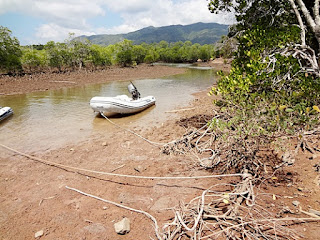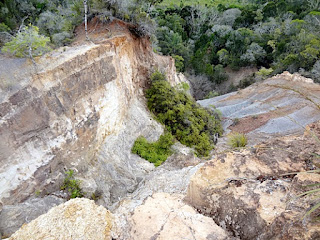As we neared the Honey River, aka Baramahamay River, we heard other cruisers talking on the VHF radio about a river excursion by dinghy. We anchored just after they left to head upriver and we hurried to drop our dinghy in the water and follow them. This dhow was anchored along the river bank as we started up the mangrove river.
We caught the pack soon. They were slowed as they'd picked up a local dugout canoe and given them a tow. The canoe was so overloaded with huge bags of rice and people that there were mere inches of clearance between the water and the edge of the canoe. The canoes leak in the best of times and it seems someone's full-time job is to bail as they go. We passed this village and the men came out to the shore to watch us go by. Some folks stopped here on the way back down and found them to be Seventh Day Adventists holding a 'reading'. One man gave a cruiser a 'gift extraordinaire' of a dried fish skeleton that is used like an emery board or pumice stone to rub off rough skin.
A mangrove creek exploration by dinghy.
We all followed the local dugout to their village. This is the landing for the village.
Our dinghy, OTIS, sitting in the shallow mud, tied to the root of the tree.
Our group of white folks invading the local village up the creek. The local guy drove stakes into the soft mud so the dinghies could tie off to them.
Unloading the dugout canoe.
A boat building/rebuilding project, with the village above it. A closer look and you can easily see why they need a full-time bailer. They don't have caulk to seal the cracks. They use old motor oil, mixed with a local sap to create the waterproofing they use here.
The local guy taking off a few sticks from the gate so we could walk to his village. The fence keeps the cows in.
The village a bit farther inland than we'd have guessed.
The local chief of the village, sitting in the shade under a big mango tree. He was cracking these spines from the fan palm, about every foot or so, he'd bend it to crack it. They use these spines, stuck onto sharpened sticks side by side, to make walls of their homes.
The inside of the spines look like corrugated cardboard and are soft enough to poke a stake through.
The background hills were really dark pink, but they show up much paler here.
A set of cow ears, still attached to each other, hang on the pole where sticks are set to dry until used to build a new hut.
One of the village kids.
The local climbed a ladder and picked us some fresh mangoes as a gift.
A local mother and child resting in the doorway of their home.
Helmut and Jason yakking in the village. You can see the wall panels made from those fan palm spines. A new hut is being constructed in the background.
A little detour up a creek to see more colorful shoreline.
We saw areas where someone had staked out areas and we wondered about their use. We saw some burned logs in some and wondered if they use these places to make charcoal.
Another colorful cliff along the river.
This house on the top of the hill where we anchored in the Honey River belongs to a Rasta man. He came out to talk and see if we wanted mud crabs. I tried to get him to find me some honey and he said he'd look around and let me know if he found some, but there isn't honey here now. He didn't know enough English to have a complex conversation, but he told me he used to have dreadlocks down to his waist and was forced to cut them off because the folks here thought he was suspicious. He's got a nice home up the carved mud stairs.
A local dhow sailing up the river at sunset.
On our second river trip, we pulled into this mud flat and Helmut stayed behind to mind the dinghies. Since a dinghy had been stolen from a yacht in our anchorage just a few days earlier, he was anxious about leaving them unattended in this backwater tributary of the river.
We climbed up this ravine from the mud flat to wander inland and see what there is to see.
The path at the top is across a rocky bit of wasteland but we followed the little trail.
Looking out over the valley on the other side. Lots of trees and little sign of people.
This hillside reminds me of the rainbow rock in Colorado where they cut the interstate through into the foothills years ago.
The reddish orange gravel and dirt of the top of the hill as we look out to the river in the distance.
The layers in the rock were interesting and I would love to have spent more time exploring the geology of the area.
The colors of the land in the hillsides are always changing.
A distant view of the river from our trail.
We didn't really see any destination from up here, so we just walked a short ways and then traced our steps back. Nothing up here but a cow path and one small hut in the distance.
The Honey River from afar.
An inland valley. The yellowish growth is bamboo, I believe. Someone in the group could spot huts way off in the distance but I couldn't see them,
A local bird with a weird crest that stuck up from its head.
Looking back at a canyon of colorful rock we passed.
Looking down that valley the other direction.
This is the ravine we climbed up and now had to find a way down. One guy backed down it, Kirstin took the steep mud path to the right and I tried to walk down frontways. I made it most of the way before the loose gravel caused me to fall on my butt and I came up with a bit of road rash on my thigh, but it wasn't bad.
The muddy channels through the mangroves in the river.
Someone started building a canoe but we saw no signs of any recent activity here.
A net across the river tributary we were navigating. It was loose and the net was deep enough for us to cross over it.
We reached a tiny village at the end of the waterway here. Some scrawny chickens and a couple of mortars turned upside down to keep them dry. They pound rice in them with the stick/pestles laying there.
These were the villagers at the end of the waterway. Very few of them and no children in sight. When I asked in French where the children were, they just gave me blank looks. This far from everything, they don't even learn French; they speak Malagasy only and we couldn't communicate. They don't see many people way back in here and they didn't really know what to do around us. I gave them a jar and an old bow roller and they were happy enough, but we didn't stay long.
The rest of the vilage. Very small. We had to leave to catch the outgoing tide in the river.
This man thought it was important to show us he could strike a pose as we left. Strange place.
This is the end of the waterway at the little village. We headed back out the waterway to the boats anchored in the main channel of the Honey River.
Jason concentrating on getting us back out. Only one wrong turn the whole way.
The mud from the villages ended up in our dinghy and Jason had quite a job to clean it out.
A sunset in the Honey River.
A local dhow rides the incoming tide up the river past us.





















































No comments:
Post a Comment